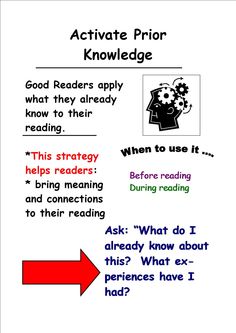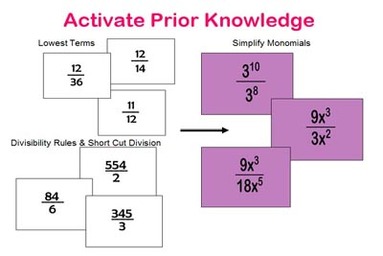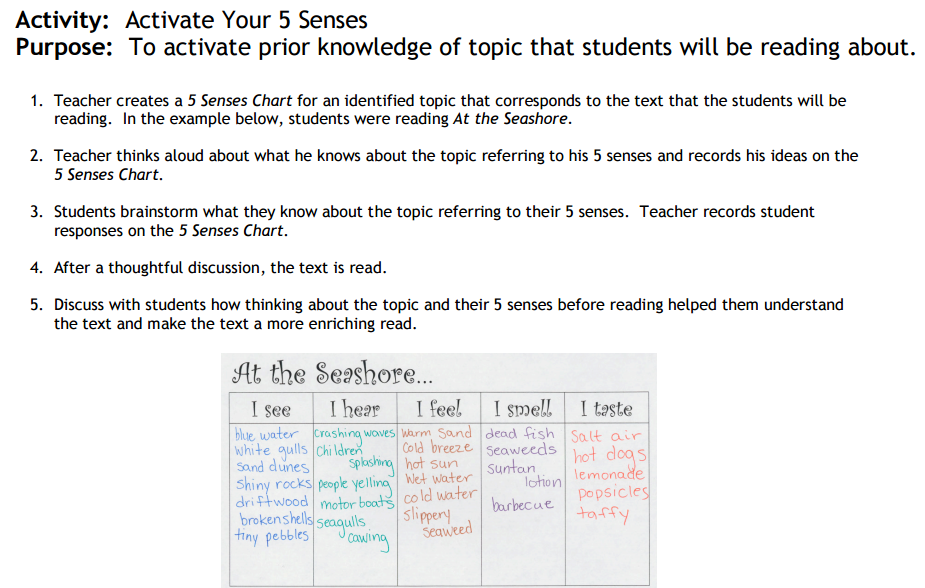"Activating prior knowledge is something that we do naturally as adult readers, as mature readers. We always relate what we're reading to something we know. As a matter of fact when we read we really have to think about those connections. Sometimes students don’t access their background knowledge because they never think that it's important or if they don’t have the background knowledge the teacher doesn’t have an opportunity to really build that background knowledge" (Clewell, 2012).
|
|
The video link above is for 6-8th grades for reading ELLs. This video demonstrated how to incorporate students prior knowledge to understand the text. This is important to have background information that one can relate to a text, especially when English is not the first language of the student.
The YouTube video to the left is demonstrating how to activate student's prior knowledge before the lesson to help them figure out what the text might be about. It also talks about how student use their schema to help them predict what the text might be about. The teacher questions her students to elicit their knowledge before.
|

Definition/Description: Activating Prior Knowledge is important in students understanding, because it allows them and helps make connections to the new information. By using what students already know, it helps the teacher assist students with the learning process because it give him/her an idea of what students know and what they still need to learn. It is simply to use background knowledge to make understanding of what the text mean. According to schema theory, as students learn about the world, they develop a schema and are allowed to make connections to many other things. Piaget’s schema theory make activating prior knowledge before reading essential, because according to his research when we can connect something “old” to something new it helps us better understand the new. As students are reading they are able to access their schema and make understand of the text and use their experiences. When students and teachers applied schema theory to reading comprehension readers constantly connect their background knowledge to the new knowledge in a text to help them make sense of the reading (Gunning, 2012). For struggling reader this strategy will allow them to make connections to what they already know about prior experiences or material. It will help them be prepared in understanding new content, because they will be thinking about how to use their prior knowledge to understand new information (Miller Veatch, 2011). Activating prior knowledge not only helps students make connections, but it helps them become engaged as well!
|
Purpose: To help them make connections of prior knowledge and apply it into the new material. This helps students understanding what they are reading. Since background knowledge is made up of a person's experiences with the world, with his or her concepts for how written text works, word identification, print concepts, word meaning, and how text is organized, students are constantly able to apply prior learning into the new information.
Tips:
|
Differentiation:
|

Content Area Examples:
Reading:
Reading:
- Questioning before, during, or after a story.
- Have students share an experience related to the topic with a partner.
- Relating a story that might be in their culture, such as Cinderella is in many different cultures
- Questioning before, during, or after lesson, activity, etc.
- Have student relate new material to existing, for example how does adding and subtracting relate.
- How can you use same math strategies in a new concept, example how does problem solving tie over from adding to subtracting.
- Questioning before, during, or after lesson, activity, etc.
- Real life experience they have has related to the topic.
- Questioning before, during, or after lesson, activity, etc.
- Real life experience they have has related to the topic
Lesson Example:The lesson below demonstrate how students can use more than just information, but they can also use their prior experience, such as sense, to help understand a book, topic, or lesson. This would help struggling readers, because even though our students might have different needs, language, and levels, they all, for the most have have some sense. Some students might not have all, such as a student might have a visual or hearing problem, but they should be able to relate something else about the topic, such as taste or touch. This lesson example demonstrates how this strategy is one way that can be used for struggling readers to apply their past experiences and their sense to understand a complicated text, story, topic, or lesson (Into the book, 2015).
Additional Links for: Information, Lessons, and Material
References:
Echevarría, J., Vogt, M. E., & Short, D. (2013). Making content comprehensible for Elementary English language learners: The SIOP model. Boston, MA: Allyn & Bacon.
Gunning, T. G. (2012). Creating literacy instruction for all children in grades pre-K to 4. 2nd Edition. Boston: A and B.
Into the book: Reading Resources (2015). Wisconsin Educational Communications Board. Retrieved from http://reading.ecb.org/
Stec, M., (2014).Prior knowledge (Schema) Anchor Char). [imagine]. Retrieved from 2015.https://www.pinterest.com/pin/182184747401665335/
Wayne Township HOSTS (n.d). [Chart with definition and use before and during reading]. Retrieved from
http://www.wayne.k12.in.us/hosts/reading_strag.asp
Echevarría, J., Vogt, M. E., & Short, D. (2013). Making content comprehensible for Elementary English language learners: The SIOP model. Boston, MA: Allyn & Bacon.
Gunning, T. G. (2012). Creating literacy instruction for all children in grades pre-K to 4. 2nd Edition. Boston: A and B.
Into the book: Reading Resources (2015). Wisconsin Educational Communications Board. Retrieved from http://reading.ecb.org/
Stec, M., (2014).Prior knowledge (Schema) Anchor Char). [imagine]. Retrieved from 2015.https://www.pinterest.com/pin/182184747401665335/
Wayne Township HOSTS (n.d). [Chart with definition and use before and during reading]. Retrieved from
http://www.wayne.k12.in.us/hosts/reading_strag.asp

